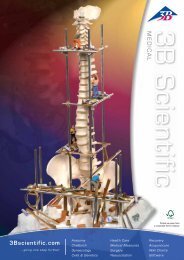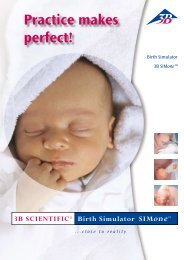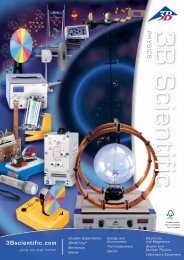3B Scientific - Physics & Engineering Experiments
3B Scientific - Physics & Engineering Experiments
3B Scientific - Physics & Engineering Experiments
Create successful ePaper yourself
Turn your PDF publications into a flip-book with our unique Google optimized e-Paper software.
UE1050201<br />
Mechanics / Harmonic oscillation<br />
Variable g Pendulum<br />
UE1050201<br />
BASIC PRINCIPLES<br />
The period of a pendulum is determined mathematically by the length of<br />
the pendulum L and the acceleration due to gravity g. The effect of the<br />
gravitational acceleration can be demonstrated by tilting the axis of the<br />
pendulum so that it is no longer horizontal.<br />
ϕ<br />
When the axis is tilted, the component of the gravitational acceleration g<br />
that is parallel to the axis g par<br />
is rendered ineffective by the fact that axis is<br />
fixed (see Fig.1). The remaining component that is effective g eff<br />
is given by<br />
the following equation:<br />
L<br />
m<br />
(1)<br />
g eff = g ⋅ cos α<br />
α: is the inclination of the axis to the horizontal<br />
α<br />
g eff<br />
When the pendulum is deflected by an angle ϕ from its rest position a suspended<br />
weight of a mass m experiences a returning force of the following<br />
magnitude:<br />
g<br />
g par<br />
(2)<br />
F = −m⋅<br />
g eff ⋅ sinϕ<br />
For small angles the equation of motion of the pendulum comes out as the<br />
following:<br />
Fig. 1: Variable g pendulum (schematic)<br />
(3)<br />
m⋅L<br />
⋅ϕ + m⋅<br />
geff ⋅ ϕ = 0<br />
The pendulum’s angular frequency of oscillation is therefore:<br />
(4)<br />
ω =<br />
g eff<br />
L<br />
T / s<br />
5<br />
E X PERIMEN T<br />
PROCEDURE<br />
• Measure the period T as a function of<br />
the effective component of the gravitational<br />
acceleration g eff<br />
.<br />
• Measure the period T for various pendulum<br />
lengths L.<br />
OBJECTIVE<br />
Measure the period of an oscillating pendulum as a function of the effective component of<br />
the gravitational acceleration<br />
SUMMARY<br />
The period of a pendulum is lengthened by tilting its axis away from the horizontal, since the effective<br />
component of the gravitational acceleration is reduced.<br />
EVALUATION<br />
Equation (4) implies that the period of the pendulum is as follows:<br />
T = 2π<br />
L<br />
geff<br />
Thus, shortening the pendulum causes the period to be shorter and<br />
reducing the effective component of the gravitational acceleration makes<br />
the period longer.<br />
0<br />
0 5<br />
10<br />
g eff<br />
/ m s -2<br />
2<br />
required apparatus<br />
Quantity Description Number<br />
1 Variable g Pendulum 1000755<br />
1 Support for Photogate 1000756<br />
1 Photo Gate 1000563<br />
1 Digital Counter (230 V, 50/60 Hz) 1001033 or<br />
Digital Counter (115 V, 50/60 Hz) 1001032<br />
1 Tripod Stand 150 mm 1002835<br />
1 Stainless Steel Rod 470 mm 1002934<br />
Fig. 2: Period of the pendulum as a function of the effective component of<br />
the gravitational acceleration<br />
Line calculated for pendulum length L = 30 cm<br />
48 <strong>3B</strong> <strong>Scientific</strong>® <strong>Experiments</strong><br />
...going one step further<br />
49















